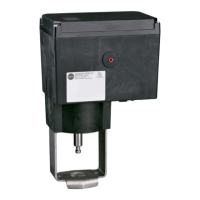EB 8331-4 EN 16-15
Annex A (conguration instructions)
16.13 Applications
Application: Positioner (POSI)
The actuator stem's position directly follows
the input signal.
Application: PID controller (PID)
The set point adjustable at the actuator is
used to position the valve using a PID algo-
rithm. The input signal at IN1, IN2 or IN3 is
used as the process variable. The PID con-
troller is adjusted using the parameters: Pro-
portional-actioncoefcientK
P
, Reset time T
N
,
Derivative-action time T
V
and Operating
point Y
0
:
Theproportional-actioncoefcientK
P
acts as
gain.
The reset time T
N
is the time it takes for the
integral component during a step response
in a PI controller to produce a change in the
manipulated variable identical to the change
produced by the P component. Increasing
the reset time T
N
reduces the rate of change
in the output when the set point deviation is
constant.
The derivative-action time T
V
is the time it
takes the rise response of a PD controller to
reach a certain manipulated variable value
earlier than it would take the response with
the P component only. Increasing the deriva-
tive-action time T
V
causes an increase in the
manipulated variable amplitude when the
rate of change is constant. After ramped
changes of the set point deviation, a longer
derivative-action time T
V
causes the D com-
ponent to have a longer effect.
The operating point Y
0
determines the posi-
tioning value, which is fed to the controlled
system when the process variable is the same
as the set point. The operating point is nor-
mally only important for P and PD control-
lers, but it can also be set for control strate-
gies PI, PID and I due to the possible limita-
tion of the integral-action component. For
control strategies with integral-action compo-
nent, the operating point can also be used
as the initial value for a restart.
When the PID application is used for tem-
peraturecontrolwithaPt1000sensor,the
temperature sensor is connected at the IN3
input(seethe'Installation'section).Pt1000
sensors can also be connected to the IN1
and IN2 inputs. Their measured values can
be read out over the RS-485 interface as
Modbusdatapoints(seesection16.16).
Application: Two-step mode (2STP)
The binary input IN2 is used for this func-
tion. When the binary input is in the active
switching state, the actuator stem retracts
(100%oftheadjustedtravelrange).When
the binary input is in the inactive switching
state, the actuator stem moves to the closed
position(0%).
Application: Three-step mode (3STP)
The binary input IN2 is used for this func-
tion to retract the actuator stem and binary
input IN3 to extend the actuator stem.
Application: Temperature closed-loop con-
trol upon input signal failure (POSF)
The travel follows the input signal. Upon fail-
ure of the input signal, the set point deter-
mined in the actuator by the integrated PID
controller is used to position the stem.

